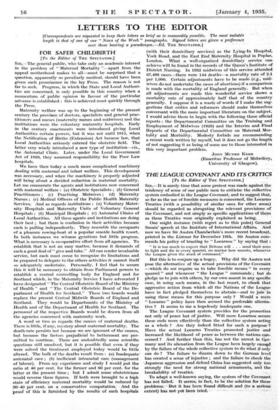LETTERS TO THE EDITOR [Correspondents are segue . sled to keep
their letters as brief as is reasonably possible. The most Suitable length is that of one of our " News of the Week" paragraphs. • Signed letters' are giben`a preference over those bearing a pseudonym.—Ed. THE SPECTATOR.]
FOR SAFER CHILDBIRTH
[To the Editor of THE SPECTATOR.]
Sia,—The general public, who take only an academic interest in the problem of " Maternal Mortality "—apart from the appeal motherhood makes to all—must be surprised that a question, apparently so peculiarly medical, should have been given such prominence in the lay Press. The reason is not far to seek. Progress, in which the State and Local Authori- ties are concerned, is only possible in this country when a momentum of public opinion in favour of the particular advance is established : this is achieved most quickly through the Press.
Maternity welfare was up to the beginning of the present century the province of doctors, specialists and general prac- titioners and nurses (maternity nurses and midwives) and the institutions were the voluntary maternity hospitals. Early in the century enactments were introduced giving Local Authorities certain powers, but it was not until 1915, when the Notification of Births (Extension) Act became law, that Local Authorities seriously entered the obstetric field. The latter very wisely introduced a new type of institution—viz., the Antenatal Clinic. Later, under the Local Government Act of 1929, they assumed responsibility for the Poor Law hospitals.
We have then today a much more complicated machinery dealing with maternal and infant welfare. This development was necessary, and when the machinery is properly adjusted will bring about a decided reduction in maternal mortality. Let me enumerate the agents and institutions now concerned with maternal welfare : (a) Obstetric Specialists ; (b) General Practitioners ; (c) Practising Midwives ; (d) Maternity Nurses ; (e) Medical Officers of the Public Health Maternity Services. And as regards institutions : (a) Voluntary Mater- nity Hospitals and Maternity Units of Voluntary General Hospitals ; (b) Municipal Hospitals ; (c) Antenatal Clinics of Local Authorities. All these agents and institutions are doing their best ; but there is confusion in their activities because each is pulling independently. They resemble the occupants of a pleasure rowing-boat at a popular. .seaside health resort. In both instances we witness gyrations but little progress. What is necessary is co-operative effort from all agencies. To establish that is not an easy matter, because it demands of each a good deal of " give and take." All can render invaluable service, but each must come to recognize its limitations and be prepared to delegate to the others activities it cannot itself so adequately undertake. Personally, I feel that to secure this it will be necessary to obtain from Parliament powers to establish a central controlling body for England and for Scotland which, in the Maternity Service I have advocated I have designated " The Central Obstetric Board of the Ministry of Health " and " The Central Obstetric Board of the De- partment of Health for Scotland." These two boards would replace the present Central Midwife Boards of England and Scotland. They would be Departments of the Ministry of Health and of the Department of Health for Scotland. The personnel of the respective Boards would be drawn from all the agencies concerned with maternity work.
A word or two as regards the causes of maternal deaths. There is little, if any, mystery about maternal mortality. The death-rate persists not because we are ignorant of the causes, but because the factors prejudicial to betterment are per- mitted to continue. There are undoubtedly some scientific
questions still unsolved, but it is possible that even if they were solved the treatment employed today would be little altered. The bulk of the deaths result from : (a) Inadequate' antenatal care ; (b) inefficient intranatal care (management of labour). From my experience and study I would put the ratio at 40 per cent. for the former and 60 per cent.' for the latter at the present time ; but I adridt some obstetricians would reverse these figures. If both were brought to a high state of efficiency maternal mortality would be reduced by 30-40 per cent. on a conservative computation. And the proof of this is furnished by the results- of such hospitals (with their domiciliary services) as the Lying-In Hospital, York Road, and the East End Maternity, Hospital in Poplar, London. What a well-organized doiniciliary service can achieve will, be fmind in the records of the Queen's Institute of District Nursing. In 1932 midwives of this service attended- 67,496 cases-7there were 144 deaths—a mortality•rate of 2.1 per 1,000. Certain adjustments have to be made. (e.g.; mid- wives do not undertake the cases of abortions) if a comparison is made with the mortality of England generally. But when all adjustments are made this wonderful service shows a mortality rate of approximately half that of the country generally. I suppose it is a waste of words if I make the sug- gestions that critics and reformers should make themselves conversant with the more important literature on the subject. I would advise them to begin with the following three official reports : the Departmental.Committee on the Training and Employment of Midwives (1929) and the Interim and Final Reports of the Departmental Committee on Maternal_ Mor- tality and Morbidity. Modesty forbids me recommending a recent work written by myself, but it does not go thelength of not suggesting it as being of some use to those interested in this very important problem.
JOHN MUNRO KERR
(Emeritus Professor of Midwifery, University of Glasgow).






































 Previous page
Previous page